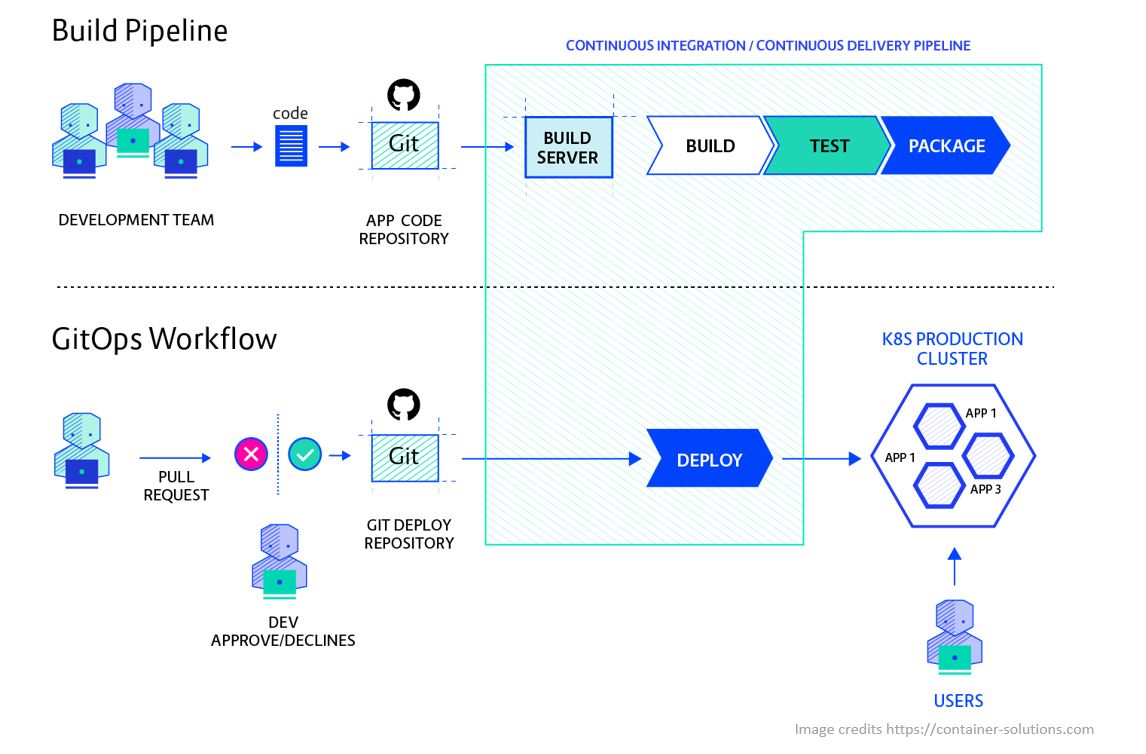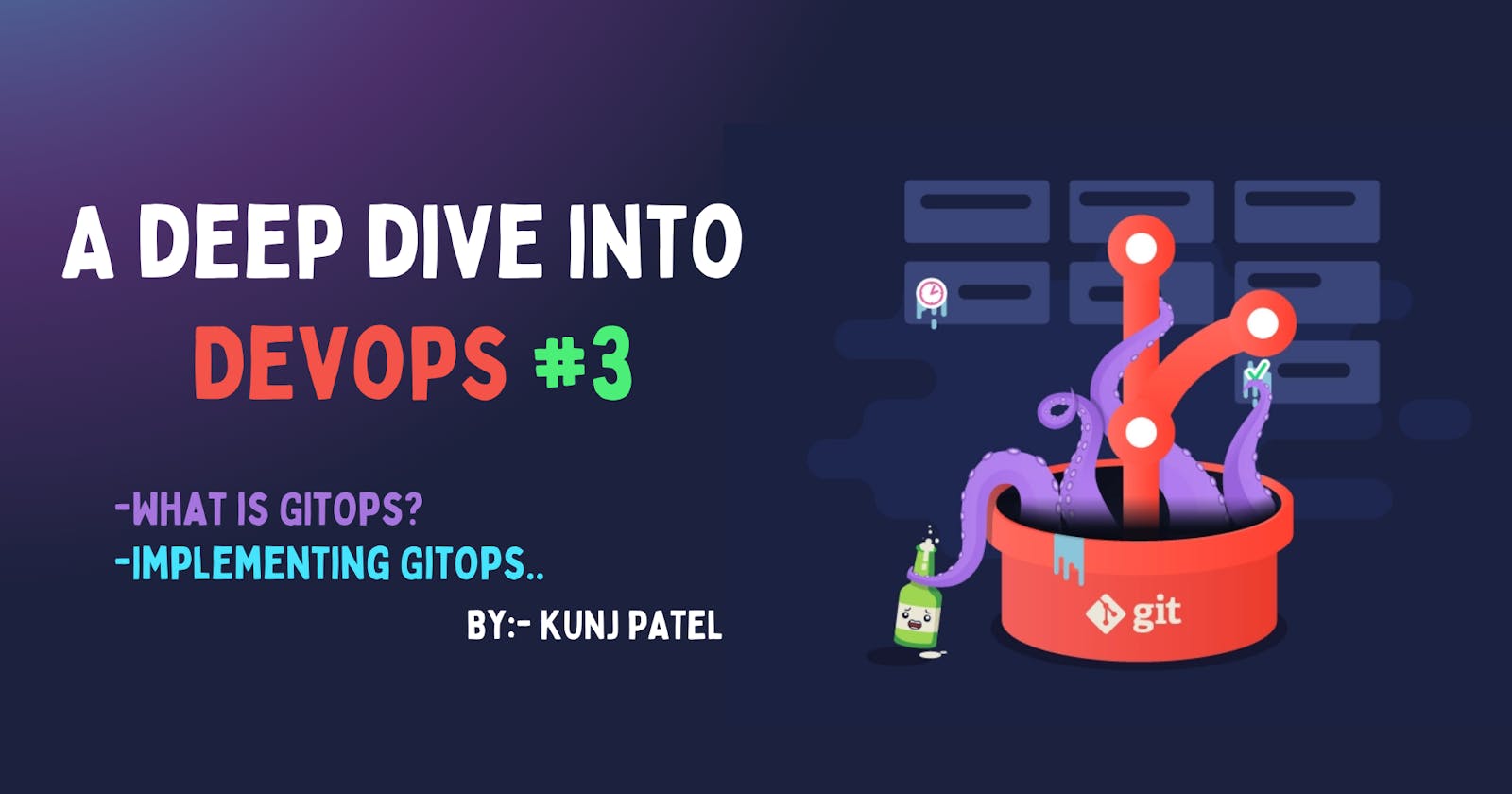A Deep dive into DevOps #3
Learn how GitOps is the best practice to implement CI/CD ? 🚀
GitOps is a relatively new development methodology that gained a lot of popularity in recent years, especially in the DevOps community. In simple terms, GitOps is a way of managing the infrastructure and the applications in a declarative manner backed up by version control using the Git repository.
GitOps provides significant advantages for teams who want to adopt a continuous deployment approach in their development cycle. It can help organizations to optimize their software delivery process through automation and monitoring, reducing manual communication and improving visibility and transparency across the development cycle.
What is GitOps?
GitOps is an operating model for Kubernetes clusters and other cloud-native applications. This methodology employs a declarative approach to infrastructure and application management, centered around the Git version control system. It provides a clear separation between the application, configuration, and infrastructure code, making it easier for teams to manage, deploy, and scale their applications and infrastructure in a repeatable and scalable way.
GitOps allows developers to define the desired state of their applications and infrastructure in a Git repository, and then use Git tools to automate the deployment of these changes to the corresponding environment, such as staging or production. This Git-centric approach to application management brings many benefits to teams looking to improve their development workflows and optimize their DevOps practices.
GitOps principles
GitOps is built on several principles that guide the implementation and use of this methodology. These principles are as follows:
Declarative infrastructure and configuration management
At the heart of GitOps is the idea of declarative infrastructure and configuration management. Rather than relying on imperative commands and manual configuration management tools, developers use declarative code to define the desired state of their infrastructure and applications. This code is then stored in a Git repository, allowing for version control and safe rollbacks while making it easier to track changes over time.
Automation and Continuous Deployment
GitOps empowers development teams to automate the entire deployment process, from code commits to cluster updates. The declarative nature of GitOps allows for continuous deployment, which enables teams to roll out new features or updates quickly, safely, and reliably, without manual intervention.
Git as a single source of truth
GitOps uses Git as a single source of truth to manage application and infrastructure configuration. All changes made to the infrastructure and application configuration are done through Git pull requests, which provide a transparent, auditable record of changes making it easier for teams to track and manage them over time.
Observability and Monitoring
GitOps provides increased observability and monitoring throughout the development cycle. It enables teams to use GitOps pull request mechanism for proposing and reviewing changes, and GitOps commit history for tracking changes and debugging. This approach makes it easier to manage configurations and infrastructure changes and gives insight into the changes going on in the software development process.
How GitOps works
GitOps provides a clear definition of how the application and infrastructure should be designed and deployed. It follows a simple workflow that revolves around the Git repository, consistent declarative states and the use of automation to continuously apply configurations through pull-based pipelines.
Here's what GitOps workflow looks like:

The software development team commits their infrastructure and application code into a Git repository hosted in a source control management (SCM) system such as GitHub or GitLab.
The GitOps operator continuously monitors the Git repository for new changes.
When changes are detected in the repository, the GitOps operator applies the configuration using automation tools like Kubernetes, Terraform, or other configuration management tools.
The GitOps operator then waits for the new environment to be updated to a healthy state.
If changes are successfully applied, the new state of the infrastructure and application is stored in the Git repository. If there are any errors, changes are rolled back to previous versions automatically.
Development teams can roll back changes at any time via Git, allowing them to quickly revert changes if necessary.
This automated approach to deployment provides security, transparency, and traceability throughout the development cycle.
Key benefits of GitOps
GitOps provides a wide range of benefits to software development teams. Here are some of the key advantages of GitOps:
Improved development workflows
GitOps provides a structured, automated approach to deployment that improves development workflows, makes it easier for teams to collaborate, and reduces the time and effort required to manage infrastructure and deployments.
Increased reliability and scalability
With GitOps, continuous delivery and deployment are possible with minimal manual intervention. This enables teams to deliver applications quickly and with more reliability while responding efficiently to unexpected changes in demand.
Greater visibility and control
GitOps enables teams to manage and monitor the application development process in real-time, providing full visibility of the application's state and any updates made to it.
Better governance and compliance
GitOps allows teams to apply governance policies through code while providing traceability and auditability through Git's version control system. This makes it easier for teams to implement compliance policies at scale.
Reduced risk and errors
With GitOps, the risk of errors and mistakes in infrastructure or application code is significantly reduced. This is because it simplifies the deployment process and reduces the dependency on manual configuration editing, resulting in a predictable and repeatable deployment process.
Implementing GitOps in software development
Implementing GitOps in a software development environment involves a few steps, which are:

Step 1: Setup the GitOps environment
To implement GitOps, it is essential to have a Git repository and a robust Kubernetes cluster.
Step 2: Define the desired state of infrastructure and application
Decide on code components that define the infrastructure and application's desired state. This includes Kubernetes StatefulSet, Secrets, ConfigMaps, NetworkPolicy, etc., as well as the components of the application like Docker images and endpoints.
Step 3: Implement a GitOps operator
Install a GitOps operator like Argo CD, Flux or Jenkins X. This operator can be used to automatically compare the desired state of infrastructure and application with the running instance in Kubernetes.
Step 4: Automate deployments through GitOps
Use automation tools to apply changes via GitOps, enabling the entire process to become more reliable, predictable and scalable.
GitOps sounds technical right??👀
let's understand it with real-world examples:-
Imagine you and your friends want to build a big tower with your toys. To make sure everyone is working on the same tower, you could use a special book where you write down all the instructions on how to build the tower.
GitOps is like that special book, but for computer programs. People can write down instructions on how to build and change the program, and everyone can see those instructions in the book. That way, everyone knows what changes are happening and can work together to build a better program.
So, GitOps helps people work together on computer programs by keeping everyone on the same page and making sure everyone knows what's happening with the program.
you can thank me by reacting to this one and make sure you follow 🙏
see you soon at the next one 👋
